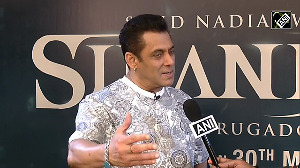Ask a friend what he would buy if he had a bigger bank account and he might rattle off a list that includes a limited-edition sports car, a round-the-world trip or a million-dollar beachfront home.
Goods by Gucci, however, top the lists of luxury brand lovers. That's according to an online survey conducted late last year by The Nielsen Company, a market research firm. It asked 25,000 consumers in 48 countries which luxury brand they would buy if money were no object. Besides Gucci, respondents chose Chanel, Calvin Klein, Louis Vuitton and Christian Dior.
In pictures:
Most desirable luxury brands
Where to find designer deals worldwide
It's easy to see why Gucci reigns. Worldwide sales, though recently tapered, have jumped since Mark Lee became president of the company in 2004, then CEO the following year. In 2007, sales increased 11 per cent; that's on top of a 17 per cent increase in 2006 and a rise of 18.4 per cent in 2005. Gucci is a part of the Gucci Group, which has a number of fashion brands in its portfolio, including Yves Saint Laurent and Sergio Rossi. PPR, a French holding company publicly traded on the Euronext exchange in Paris, owns the Gucci Group.
"Gucci manages to offer high fashion and very commercial items," says Michael Macko, fashion director at Saks Fifth Avenue. "That red and green stripe is some of the most iconic luxury branding ever created, and people want a piece of it."
Behind the brands
Born as a leather goods company, Gucci is now most well known for its logo-ed handbags. When the company opened a new 46,000-square-foot store, the largest of its 233 worldwide, on the ground level of the Trump Tower on Manhattan's Fifth Avenue last month, they also launched a "Gucci Loves New York" handbag collection which sold out within two days of opening. Proceeds from the bags went to Playground Partners Central Park Improvement Program.
In pictures:
Bespoke for every budget
Top spots for VIP shopping
Chanel and Calvin Klein tied for second. The privately held Chanel, famous for the little black dress, tweed suit and quilted handbag, was founded by Coco Chanel in 1909 and is currently helmed by Karl Lagerfeld. It stays relevant thanks to a slew of consistently classic yet stylish products. The label's current must-haves include a quilted leather envelope clutch and a sleeveless embroidered cashmere dress with pink trim; its current pitch woman is Keira Knightley.
Calvin Klein's global retail sales surged to $4.5 billion in 2006--that's an increase of 50% since Phillips Van Heusen acquired the company in 2003. It manages such reach thanks to its three labels: Calvin Klein Collection (designer apparel and accessories), ck Calvin Klein, (bridge apparel and accessories) and Calvin Klein (better apparel and accessories). Top looks for spring include slim trousers cut on the bias for men and a high-waisted white skirt suit for women.
Shopper stats
When looking at who actually buys designer brands today, the United Arab Emirates and Hong Kong come out on top. Almost one-third of survey respondents living in these areas claimed to buy the brand with the iconic interlocking-G logo. Only 7 per cent of North American shoppers polled buy Gucci products.
In pictures:
How to shop smart
World's largest malls
While designer goods are certainly desirable in emerging markets, North America was the least interested in luxury brands, with 35 per cent of respondents claiming they would not be tempted to buy even if money was not an issue. When quality comes into play, 34% of respondents in Eastern Europe, the Middle East, Africa and Latin America believe designer goods have the highest quality vs. non-designer; that figure falls to 20 per cent for both Europe and North America.
"In emerging markets such as Latin America and the Asian Pacific, designer brands are probably more of a proclamation," says David Boyd, vice president of Nielsen Global Research, "a way to set themselves apart or feel that they've arrived as part of the new economy."
Regional differences also emerge over counterfeit goods peddled at market stalls globally. Over a quarter of North Americans questioned believe that fakes are just as good as the real thing, but in Asia, where most of the fakes are produced, consumers hold them in low regard, with only 8 per cent putting them on par with the genuine article.
"People in Asia can pick out a fake bag like no one I've seen," says Boyd, "But in the US, people are less aware and less concerned, because in the US luxury brands are considered more mainstream."






 © 2025
© 2025